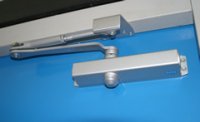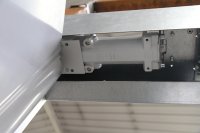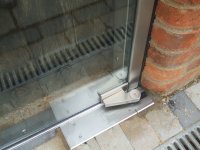Door Closers
Modern door closers have many useful functions, for which the alternative term 'door control' is actually quite appropriate. While all will close the door, to limit further access or maintain internal environments, particular models' options can also include:
- Backcheck
- Hold-open
- Delayed closing
Backcheck is often the primary reason to fit closers to external doors, as it helps to reduce injury and building damage on windy sites, by slowing down the opening and closing speeds. For internal doors, backcheck can also help prevent damage to adjoining walls if doors are flung open quickly.
Hold-open is useful for many reasons, perhaps to carry goods through, or to keep doors open during the day, or for ventilation. While the hold-open angle can be adjusted, 90° is the common setting. Doors are released by simply pulling them closed again. The hold-open function of some arms may be easily switched on or off by the user. Note that mechanical hold-open is not permitted on fire rated doors.
Delayed closing is often used on public buildings, to increase the transit time for parents with children, or people with limited mobility.
Closer Types
Closers may be broadly categorised as being either surface mounted or concealed.
Surface Mounted Closers
This is the most commonly used closer, as it is versatile and allows easy access for maintenance. Surface mounted closers may be fitted with differing arm types, as shown below.



The arm type and associated mounting side on the door affect the typical maximum opening angles as follows:
|
Arm type |
Body position |
Max. opening angle |
|
Parallel arm |
Push side of door |
155° |
|
Standard arm |
Pull side of door |
180° |
|
Slide channel |
Push side of door |
120° - 145° |
|
Slide channel |
Push side of head |
120° - 145° |
|
Slide channel |
Pull side of door |
180° |
|
Slide channel |
Pull side of head |
180° |
Note that closer bodies fitted to the pull side of the door leaf can foul an adjacent wall when the door is opened to 90°, for example in narrow corridors where the corridor width is the same as the frame width. The normal solutions are to allow a 100mm wall nib, cut a clearance recess into the wall, or specify a thicker frame.
Concealed Closers
Concealed closers may be located in the door leaf, the frame head, or underfloor, in which case they are known as floor springs. Floor springs and head mounted concealed closers are often fittted to glass doors such as the DoorTechnik GL15 or the DoorTechnik SG20, and may allow doors to be double acting if plain frames are fitted.



Floor springs and concealed closers are useful in some situations:
- Not visually intrusive – can promote a minimalist look.
- Are less susceptible to vandalism.
- Will allow doors to be opened nearer to adjacent walls or other obstructions. The closer body and arm does not protrude from the surface of the door.
- Can be helpful in anti-ligature regimes.
Fire Rated Doors
Fire rated doors must be fitted with a self closing device (a door closer) so that the doorset will resist the spread of fire. If these doors need to be held open in normal use, electro-hydraulic closers or hold-back magnets linked to the building’s fire alarm system, can allow the doors to close in the event of the alarm being triggered. Closers with mechanical hold open are not permitted, as the door would not close automatically in the event of a fire.
Inward Opening Doors
On inward opening doors, surface mounted overhead closers are normally mounted on the pull side of the door leaf, which can result in the closer body fouling an adjacent wall when the door is opened to 90°, for example in narrow corridors where the corridor width is the same as the frame width. The normal solutions are to allow a 100mm wall nib, cut a clearance recess into the wall for the closer body, or specify a thicker frame.


 +44(0)1522 693522
+44(0)1522 693522 info@doortechnik.co.uk
info@doortechnik.co.uk